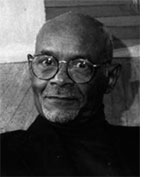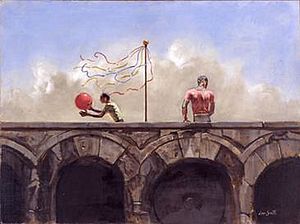Hughie Lee-Smith facts for kids
Hughie Lee-Smith (born September 20, 1915 – died February 23, 1999) was an American artist and teacher. He was known for his unique paintings that often showed lonely figures under huge skies, or empty city scenes. His art style is sometimes called 'surreal,' which means it mixes real things with dream-like or strange elements.
Contents
Early Life and Art Training
Hughie Lee-Smith was born in Eustis, Florida. When he was young, his parents divorced. His mother moved to Cleveland to become a musician. Hughie went to live with his grandmother in Atlanta. She was very strict.
He remembered that his grandmother wouldn't let him go to carnivals. He later felt that these childhood memories of balloons and ribbons appeared in his paintings.
When he was 10, he moved to Cleveland to live with his mother and grandmother. He started taking art classes. He studied at the Cleveland Museum of Art and later at the Cleveland Institute of Art. He also attended the Art School of the Detroit Society of Arts & Crafts and Wayne State University.
High School and Early Career
Hughie Lee-Smith went to East Technical High School. He was the president of the art club there. He also ran track with the famous athlete Jesse Owens. As a young person, he was active at Karamu, a community arts center. He danced, performed, and even taught art.
In 1938, Lee-Smith graduated with honors from the Cleveland School of Art. He then worked for the Federal Arts Project. This was a government program during the Great Depression. It helped artists find work. Like many artists in this program, Lee-Smith wanted his art to help with social justice and equality. He made prints about these important ideas. One of his early famous works is "The Artist’s Life No.1," a print from 1939.
Teaching and Military Service
In 1940, Lee-Smith started his first job as an art teacher. He taught at Claflin College in Orangeburg, South Carolina. He had just married Mabel Louise Everett. The pay was not very good, so he moved to Detroit.
He worked at a factory owned by Henry Ford for about three years. After that, he joined the United States Navy. He served for 19 months during World War II. While in the Navy, he was asked to create paintings to boost morale. He painted a mural called History of the Negro in the U.S. Navy. He also painted portraits of the first Black naval officers.
In 1953, Hughie Lee-Smith and Mabel Louise Everett divorced. Later that year, he earned a Bachelor of Science degree in Art Education from Wayne State University in Detroit.
Recognition and Moving to New York
In 1953, Lee-Smith won a top art prize from the Detroit Institute of Arts. He later said that after winning this award, people stopped calling him a "black artist" or "Negro artist." He felt that his race was no longer the main focus.
In 1958, Lee-Smith moved to New York City. He taught art at the Art Students League of New York for 15 years. He later moved to Cranbury, New Jersey.
Art Style and Legacy
Hughie Lee-Smith's paintings showed influences from different art styles. These included Cubism, which uses geometric shapes, and Social realism, which shows real-life social issues. He was also influenced by Surrealism, which creates dream-like scenes. He used these styles to express his own feelings in a way that was both touching and mysterious.
A writer for The New York Times described his paintings. They often had simple backgrounds, like a theater stage or a lonely city or beach. Walls would stretch under gray skies. People in his paintings looked like dancers, frozen in time. They usually wore everyday clothes, but sometimes wore strange masks. Children and circus-like items often appeared in his work. His art had a mysterious feeling, similar to the paintings of Giorgio de Chirico and Edward Hopper.
In 1967, Lee-Smith became a member of the National Academy of Design. He was only the second African-American artist to be chosen for this honor, after Henry Ossawa Tanner. Four years later, he became a full member.
In 1994, he was asked to paint the official portrait of David Dinkins. Dinkins was the former Mayor of New York City. This portrait hangs in the New York City Hall.
Exhibitions and Collections
Several museums have held special shows of Lee-Smith's work. These include the New Jersey State Museum and the Studio Museum in Harlem in 1988. The Ogunquit Museum of American Art also featured his work in 1997.
His paintings are part of many important art collections. You can find his art at places like:
- The Metropolitan Museum of Art
- The Smithsonian American Art Museum
- The Detroit Institute of Arts
- Howard University
- The San Diego Museum of Art
- The Schomburg Center for Research in Black Culture in Manhattan
In 1978, Lee-Smith met Patricia Thomas-Ferry, who was an art student. They married later that year. This marriage was very happy and lasted for the rest of his life. They made their home in New Jersey in 1981.
Hughie Lee-Smith passed away from cancer in Albuquerque, New Mexico.
Selected Works
Hughie Lee-Smith had his first solo art shows in Chicago in 1945. These were at the South Side Community Art Center and Snowden Galleries.
Here are some of his well-known paintings:
- Man Running (1965, oil on canvas)
- End of Act One (1984, oil on canvas)
- Double Exposure (1995, oil on canvas)
- Stranger (1957–1958, oil on canvas)
- Bouquet (1949, oil on canvas)
- Artist’s Life No.2 (1939, Lithograph)
Awards and Recognition
Hughie Lee-Smith received many awards for his art throughout his career:
- Cleveland Museum
- Freehand Drawing, 3rd Prize, 1938
- Linoprint, Honourable Mention, 1938
- Lithography, 3rd Prize, 1939
- Lithography, 2nd Prize, 1940
- Atlanta University
- Oil Painting, Purchase Prize, 1943
- Detroit Institute of Art
- Oil, Anthony Maiuello Prize, 1951
- EMILY LOWE AWARD, Oil, 1957
- Allied Artists of America
- Oil, Allied Artists Prize, 1958
- American Society of African Culture
- Oil, 1st Purchase Prize 1960




